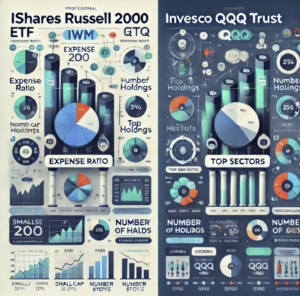
By ATGL
Updated September 24, 2024
An expense ratio is a critical factor when evaluating investment funds, as it directly impacts your returns. Whether you’re investing in exchange-traded funds (ETFs), mutual funds, or index funds, knowing how an expense ratio works and what constitutes a “good” one can significantly enhance your long-term investment strategy. In this article, we’ll break down what expense ratios are, how they’re calculated, and why they matter for maximizing your returns.
Why Are Expense Ratios Important, and What Do They Cover?
Expense ratios reflect the ongoing costs of managing a fund. These fees are deducted from the fund’s assets and are expressed as a percentage of your investment. For instance, an expense ratio of 0.50% means that for every $1,000 you invest, $5 will go toward the fund’s operating expenses each year. This may include management fees, administrative costs, marketing, and other related expenses.
By comparing expense ratios across different funds, you can better understand the costs involved and how they might affect your overall returns. While the differences may seem minimal, even slight variances can compound significantly over time.
Factors That Influence Expense Ratios
Several variables impact the expense ratio of a fund, allowing you to weigh the trade-off between costs and fund performance more effectively:
- Fund Size: Larger funds can spread costs over a wider asset base, leading to lower expense ratios.
- Fund Type: Actively managed funds typically have higher expense ratios compared to passively managed funds due to more intensive research and active trading strategies.
- Investment Strategy: Some funds may require more specialized management, increasing operational costs and, consequently, the expense ratio.
Expense Ratio Formula and Calculations
The formula for calculating an expense ratio is straightforward:
Expense Ratio = (Total Fund Operating Expenses / Total Assets Under Management)
For example, if a fund has $10 million in assets and $50,000 in annual operating expenses, the expense ratio would be:
Expense Ratio = ($50,000 / $10,000,000) = 0.005 or 0.50%
This ratio gives you a clear idea of the percentage of your investment you’ll use to cover fund management and operational costs annually.
Differences Between Actively and Passively Managed Funds
Expense Ratios of Actively Managed Funds
Actively managed funds generally have higher expense ratios, often ranging from 0.50% to over 2%. These funds require extensive research, frequent buying and selling of securities, and hands-on management, which adds to the operating costs. Investors in actively managed funds are essentially paying for the expertise of fund managers who aim to outperform the market.
Expense Ratios of Passively Managed Funds
In contrast, passively managed funds, such as index funds and many ETFs, have much lower expense ratios. These funds track a specific market index and require minimal management. The expense ratios for these funds typically range from 0.03% to 0.25%. The lower costs make these funds appealing to long-term investors looking to minimize fees.
Typical Ranges for Expense Ratios and Where to Find Them
Expense ratios can vary significantly depending on the type of fund and its management style. As a rule of thumb, these are the average expense ratio ranges for active funds and passive funds:
- Actively Managed Funds: 0.50% to 2% or higher
- Passively Managed Funds (ETFs, Index Funds): 0.03% to 0.25%
You can find the expense ratio of a fund in its prospectus or through online fund databases, often listed on platforms like Morningstar or directly on fund provider websites.
What Constitutes a “Good” Expense Ratio?
To evaluate whether an expense ratio is “good” or “bad,” context is key. Consider these common questions investors ask about expense ratios:
- What is a 0.04 expense ratio?
A 0.04% expense ratio is excellent, typically seen in large, passively managed ETFs. This low fee means minimal overhead and allows more of your investment to grow over time. Investors seeking low-cost, long-term investments often gravitate towards funds with expense ratios in this range. - What does a 0.75 expense ratio mean?
A 0.75% expense ratio is relatively moderate for actively managed funds but high for passively managed funds. If you’re investing in an actively managed fund, a 0.75% expense ratio might be reasonable if the fund consistently outperforms its benchmark. However, for index funds or ETFs, this would be on the higher end. - What does a 1 expense ratio mean?
A 1% expense ratio indicates a relatively high cost, especially for passively managed funds. In actively managed funds, a 1% ratio might be justified if the fund’s performance is strong. For comparison, paying a 1% fee versus 0.25% could result in you losing thousands of dollars in returns over several decades due to compounding effects.
Total Cost of Ownership in Investments
Remember that the expense ratio is just one aspect of the total cost of owning an investment. Other potential costs include:
- Trading Fees: Some funds incur additional costs from frequent trading, particularly in actively managed portfolios.
- Load Fees: These are commissions charged when buying or selling certain mutual funds.
- Other Fees: Administrative or distribution fees can further reduce returns.
Examine the fund’s overall fee structure to get a complete picture of the costs.
How Expense Ratios Impact Investment Returns
The impact of expense ratios on returns becomes more pronounced over time due to compounding.
Imagine two funds, one with an expense ratio of 0.10% and another with 1.00%. If you invest $10,000 in each and they both return 8% annually before fees, here’s what you would have after 20 years:
- 0.10% Expense Ratio Fund: $45,886
- 1.00% Expense Ratio Fund: $38,336
That’s a difference of over $7,500 simply due to higher fees, underscoring the importance of selecting funds with lower expense ratios for long-term growth.
Comparing Expense Ratios Across Investment Options
When comparing different funds, you’ll often find that similar funds (e.g., large-cap equity funds) may have vastly different expense ratios. In this case, choosing a fund with a lower expense ratio can lead to better overall returns, assuming the fund’s performance aligns with market averages.
Tools like ETF comparison charts and fund screening tools on financial websites and platforms such as Morningstar or ETF.com can help you identify options with the best fee structures.
Making Informed Decisions on Expense Ratios To Ensure Good Returns
Selecting funds with lower expense ratios can significantly enhance your investment outcomes over the long term. For passively managed funds, prioritize low-cost options to maximize your net returns. When considering actively managed funds, ensure that higher fees are justified by outperformance.
For more advanced strategies on fund selection, explore our ETF Investment Strategies and ETF Asset Allocation resources, or consider signing up for an Above the Green Line membership for exclusive insights on market opportunities.






